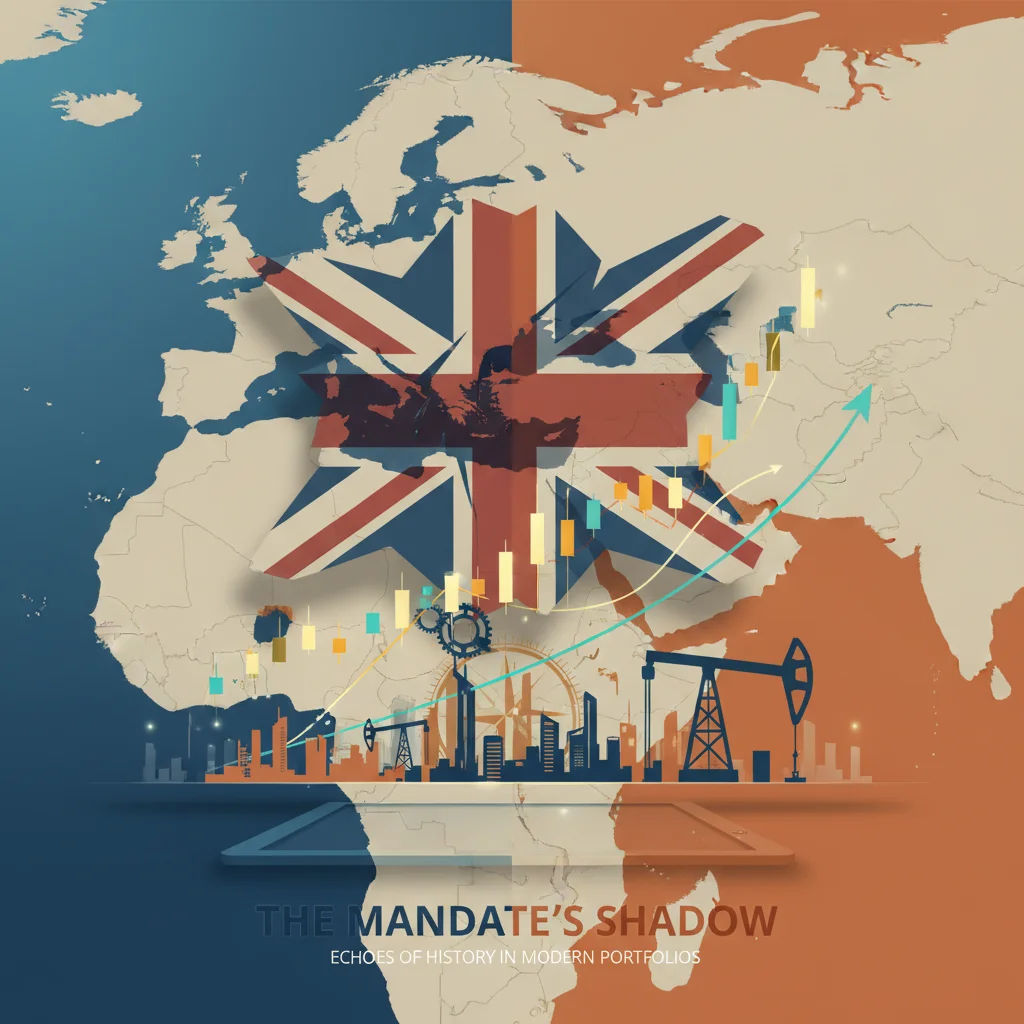
The Mandate’s Shadow: How a Century-Old British Policy Shapes Today’s Middle East Markets
The Echoes of History in Modern Portfolios
In the fast-paced world of finance and investing, the focus is relentlessly on the future: the next quarterly earnings, the next market trend, the next disruptive financial technology. We build complex models to forecast economic shifts and scrutinize real-time data to inform our trading decisions. Yet, as the recent turmoil in the Middle East reminds us, some of the most potent forces shaping today’s stock market volatility and geopolitical risk are not found in algorithms, but in archives. To truly understand the economic landscape of Israel and Palestine, one must look back a century to a foundational period whose consequences still reverberate through the global economy: the British Mandate for Palestine.
A recent letter in the Financial Times by R.C. Fassam-Wright serves as a poignant reminder that the political and economic architecture of the region was deliberately constructed. Between 1920 and 1948, British policies did more than just administer a territory; they laid the economic and demographic groundwork for a conflict that continues to challenge international stability and rattle financial markets. For investors, business leaders, and finance professionals, ignoring this history is not just an academic oversight—it’s a critical failure in risk assessment. This article will delve into the economic legacy of the Mandate, exploring how decisions made a century ago created the fault lines that define one of the world’s most complex investment environments.
An Economic Blueprint for Conflict: The Balfour Declaration and Mandate Policies
The story begins before the Mandate itself, with the 1917 Balfour Declaration. This short letter from the British Foreign Secretary was far more than a political statement; it was a powerful economic signal to the world. By promising to facilitate the establishment of a “national home for the Jewish people” in Palestine, Britain effectively underwrote a massive project of demographic and economic transformation. This declaration became the guiding principle of the subsequent British Mandate, shaping policies on immigration, land tenure, and industrial development.
Under the Mandate, the British administration created a legal and financial framework that actively encouraged Jewish immigration and capital inflow. Organizations like the Jewish Agency and the Jewish National Fund operated as quasi-state institutions, channeling international finance into land acquisition and the development of new settlements. This was a sophisticated, long-term investing strategy aimed at building the infrastructure of a future state. The banking system that emerged, the industrial enterprises that were founded, and the collective farms (kibbutzim) that were established were all part of a cohesive, well-funded nation-building project. The economic tools were modern, but the goal was rooted in a historical vision, backed by the political might of the British Empire.
The Investor's Gambit: Why 'Uncanny Timing' is a Myth in a Volatile Market
For the majority Arab population, the economic reality was starkly different. While the Mandate charter spoke of protecting the civil and religious rights of non-Jewish communities, its economic policies often resulted in their marginalization. The influx of foreign capital drove up land prices, making it difficult for traditional Palestinian farmers to compete. Large tracts of arable land were sold by absentee landlords, leading to the displacement of tenant farmers and fueling social and economic grievances. The British administration’s approach to the two communities was fundamentally asymmetric, fostering one burgeoning, industrialized economy while the other remained largely agrarian and increasingly disenfranchised.
A Tale of Two Economies: Divergent Development Under British Rule
The economic data from the Mandate period paints a clear picture of two parallel, yet profoundly unequal, economic trajectories. The Jewish community, or Yishuv, rapidly developed a modern, Western-style economy. It established the Anglo-Palestine Bank (which would later become Bank Leumi), created the Histadrut labor federation which controlled a vast network of businesses, and built factories and power plants. This was an economy driven by a clear vision, international finance, and the systematic application of modern European economic principles.
In contrast, the Palestinian Arab economy faced significant structural disadvantages. While it was not static and did see some growth, it lacked the centralized institutions, access to international credit, and political support that the Yishuv enjoyed. The British suppressed Arab nationalist movements, which also hampered the development of cohesive economic and political institutions. The 1936-1939 Arab revolt, a response to British policies and Jewish immigration, was brutally crushed, further devastating the Palestinian economy and decapitating its political leadership. As one historian noted, by the end of the Mandate, “the Yishuv had a state-in-waiting; the Palestinians had a society in tatters (source).”
To illustrate this divergence, consider the demographic and economic shifts during this period. The Jewish population grew from under 10% to roughly 33% of the total, largely through immigration (source). This rapid change placed immense pressure on the region’s resources, particularly land.
The following table provides a snapshot of the economic disparity that had emerged by the end of the Mandate era:
| Economic Indicator (c. 1945-1947) | Jewish Sector | Arab Sector |
|---|---|---|
| Share of Industrial Output | ~80% | ~20% |
| Per Capita Income (Approx.) | ~2x higher than Arab sector | Base Level |
| Literacy Rate (Adults) | Over 90% | ~25-30% |
| Access to Institutional Banking/Credit | Widespread and organized | Limited and fragmented |
Source: Based on consolidated historical economic data from various academic studies on the Mandate economy.
This data isn’t just historical trivia; it represents the creation of a structural imbalance that would define the subsequent conflict. When the British withdrew in 1948, they didn’t leave behind a single, integrated economy. They left two separate economic entities with vastly different capacities, locked in a struggle for the same land and resources.
Bitcoin in the Vault: Banking's Next Frontier or a Systemic Time Bomb?
From Mandate to Market Volatility: The Financial Aftermath
The end of the British Mandate in 1948 and the ensuing war triggered a profound economic cataclysm. For the victorious Israelis, it was the culmination of their nation-building project. They inherited the entirety of the Mandate’s infrastructure and consolidated the institutions they had painstakingly built. For Palestinians, the “Nakba” or “catastrophe” was an economic event as much as a political one. It involved the mass displacement of over 700,000 people, the loss of land, homes, and businesses, and the freezing of bank accounts containing an estimated £5 million in 1948 currency (source). This represented a near-total destruction of the Palestinian Arab economy’s capital base.
This foundational event created the economic realities we see today. Israel, despite being in a hostile neighborhood, developed a robust, technology-driven economy—the “Silicon Wadi.” Its stock market and financial institutions are deeply integrated into the global system. However, it carries a permanent “security premium” in its economy, with a significant portion of its GDP dedicated to defense spending. This geopolitical risk is a direct legacy of the unresolved conflict that began with the Mandate.
The Palestinian economy, fragmented between the West Bank and Gaza, has been unable to achieve self-sufficiency. It remains heavily dependent on international aid, subject to restrictions on movement and trade, and lacks control over its own resources. The promise of fintech and other financial technology innovations to “bank the unbanked” and foster economic growth often runs into the hard realities of checkpoints, political instability, and a fractured banking system. This is not a failure of economics or entrepreneurship, but a direct consequence of a political situation rooted in the historical events of the Mandate.
60,000 Mortgages at Risk: The Unintended Consequence of a UK Savings Overhaul
Conclusion: Why History is a Core Component of Modern Risk Analysis
The British Mandate for Palestine is a stark illustration that markets do not exist in a vacuum. They are built on political, social, and historical foundations. The policies of the Mandate, which systematically favored one population’s economic development over another’s, did not create a stable platform for growth. Instead, they engineered a structural conflict whose instability has become a permanent feature of the regional and global economy.
For the modern investor, trader, or business leader, the lesson is clear. A sophisticated understanding of geopolitical risk requires looking beyond the immediate headlines and quarterly reports. It demands a deep dive into the historical forces that shape a region’s political economy. The legacy of the British Mandate—unresolved land claims, demographic tensions, and deep-seated grievances—is not a relic of the past. It is an active variable that continues to influence everything from bond yields and stock market performance to the potential of blockchain and fintech solutions in the region. In finance, as in history, the past is never dead. It’s not even past.


